SMOOSH JUICE
D&D and Final Fantasy: Marilith – A Crossover Deep Dive – WobbleRocket

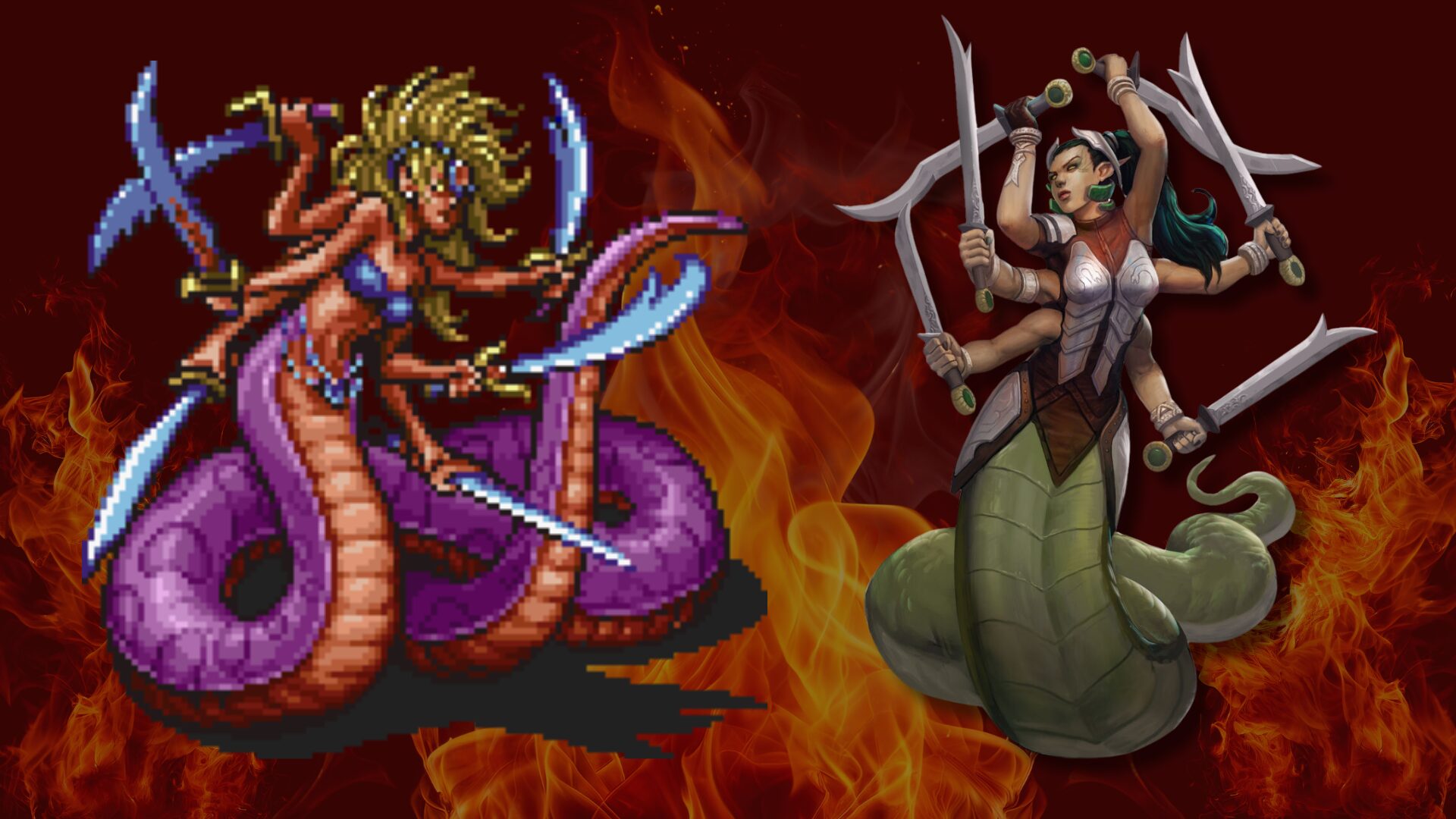
The marilith is one of my favorite monsters in Dungeons and Dragons — who doesn’t love six-armed snake-tailed female demons who want nothing more than to devour your heart? But did you know that this iconic monster also has a long history in the Final Fantasy JRPG videogame series?
According to the 2015 novel Archmage by R.A. Salvatore, Marilith was the name of a great tanar’ri demon from which all other mariliths were spawned, although this little tidbit of lore wouldn’t develop until almost 40 years after the creatures first appeared in Dungeons and Dragons.
Marilith first appears in Final Fantasy in the very first game in the series, as the Fiend of Fire, one of the game’s major bosses, although the English translation for the NES changed the name to ‘Kary.’ More on that later.
In this article, we’ll take a deep dive into the history of the marilith as she appears in each of these two franchises, starting with the first appearance of the marilith in Dungeons and Dragons.
Marilith in Eldritch Wizardry (1976)
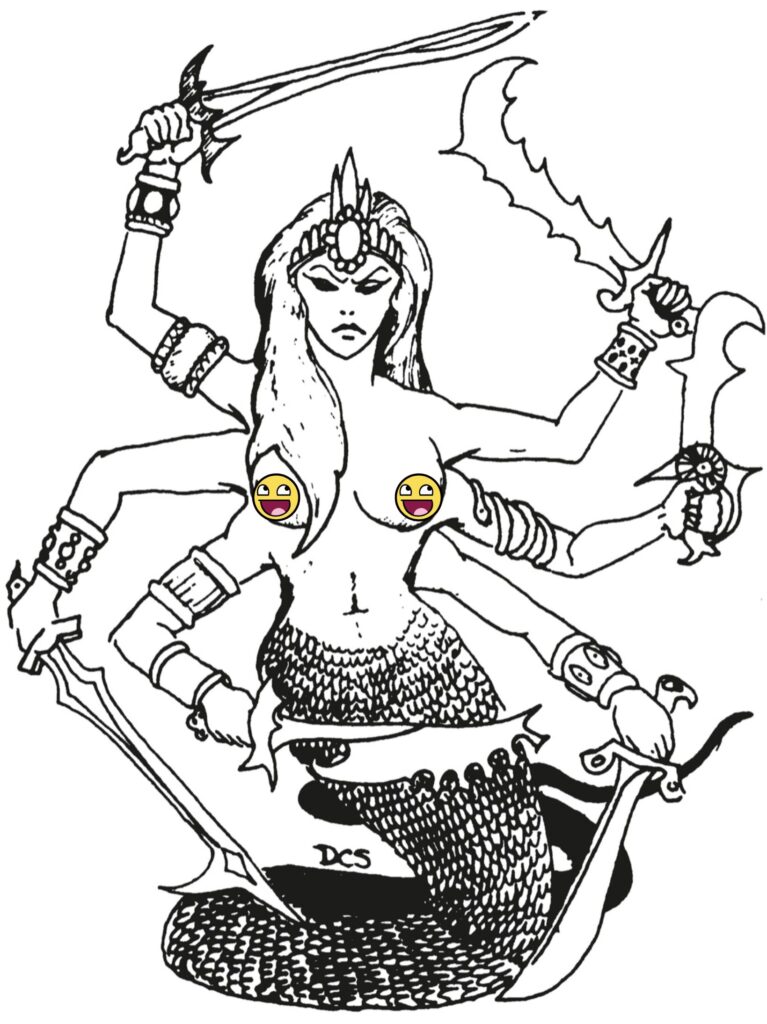
The marilith first appears in Dungeons and Dragons in the 1976 supplement Eldritch Wizardry, published by TSR Inc. for the original 1974 edition of the game. The term ‘marilith’ doesn’t actually appear in the book — the described monster is simply called a ‘Type V demon.’
Type V: Another of the female demons with a multiarmed female torso atop the body of a great snake, they are taller than a large man and far more terrible. Their six arms are all able to use weapons. These demons are 80% magic resistant, cannot be hit by non-magical weaponry, and their intelligence is high. When desiring to do so, they cause darkness in a 5′ radius. Other extraordinary abilities, any one of which can be performed as desired are: Charm person, levitate (as an 11th level magic-user), read languages, detect invisible objects, cause pyrotechnics, polymorph self, project image, and gate in a Type I (30% chance), Type II (25% chance), Type III (15% chance), Type IV (15% chance), Type VI (10% chance), or one of the Princes (5%); but the chance of successfully opening such a gate is a mere 50%.
The design is likely inspired by the Hindu death goddess Kali. Commonly pictured with four or more arms, Kali is a goddess of time, death, and destruction, often seen wielding scimitars, daggers, or tridents.
I’m not really sure where the snake tail came from. Gygax or Sutherland may have fused Kali with the Greek figure Echidna, described often as half-woman, half-snake.
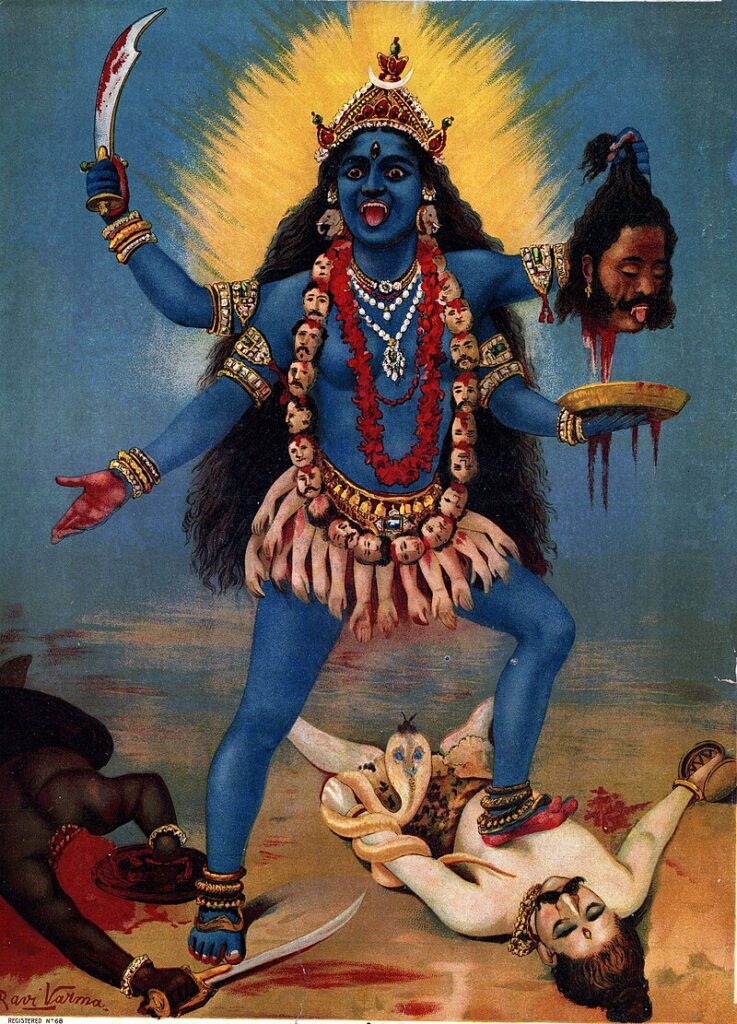
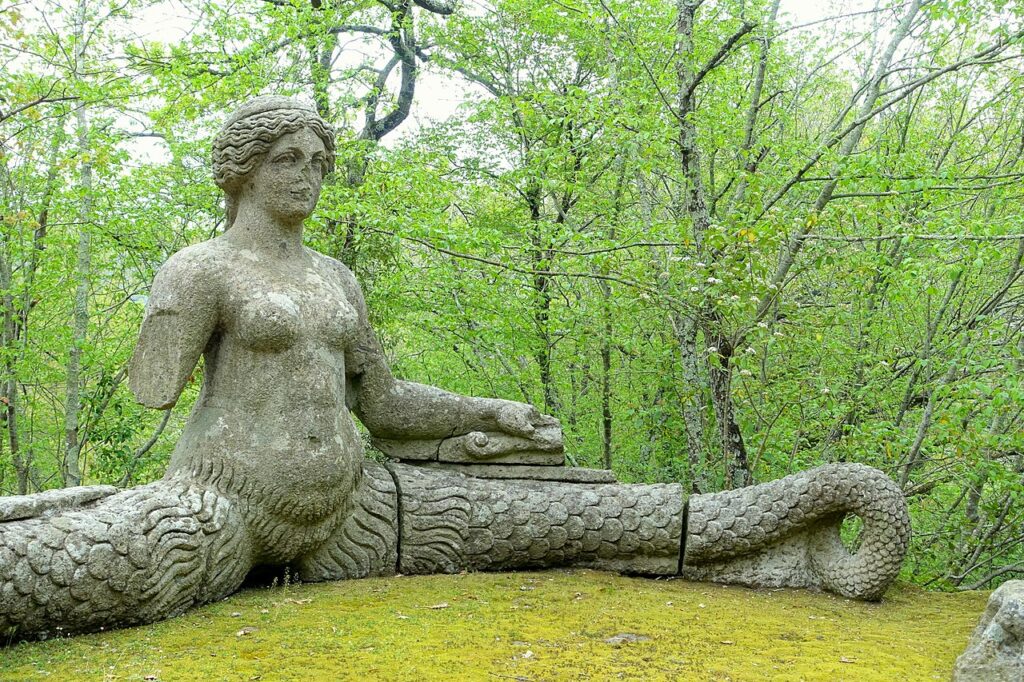
Marilith in AD&D Monster Manual (1977)
The first use of the word ‘Marilith’ appears in the stat block for Type V demons in the 1977 Monster Manual for Advanced Dungeons and Dragons. The same artwork by Dave Sutherland is used and the description is almost identical to the one from Eldritch Wizardry, with only a few small additions.
There is a new mention that they can “constrict a victim with their snakey tails’ as well as the following additional description:
Lower level demons greatly fear the domineering and cruel type V
demons. All of these creatures have names which can be used to aid in
negotiations. Demons of this type are likely to desire the sacrifice of strong warriors to them.
Marilith in Final Fantasy – Famicon/NES (1987)
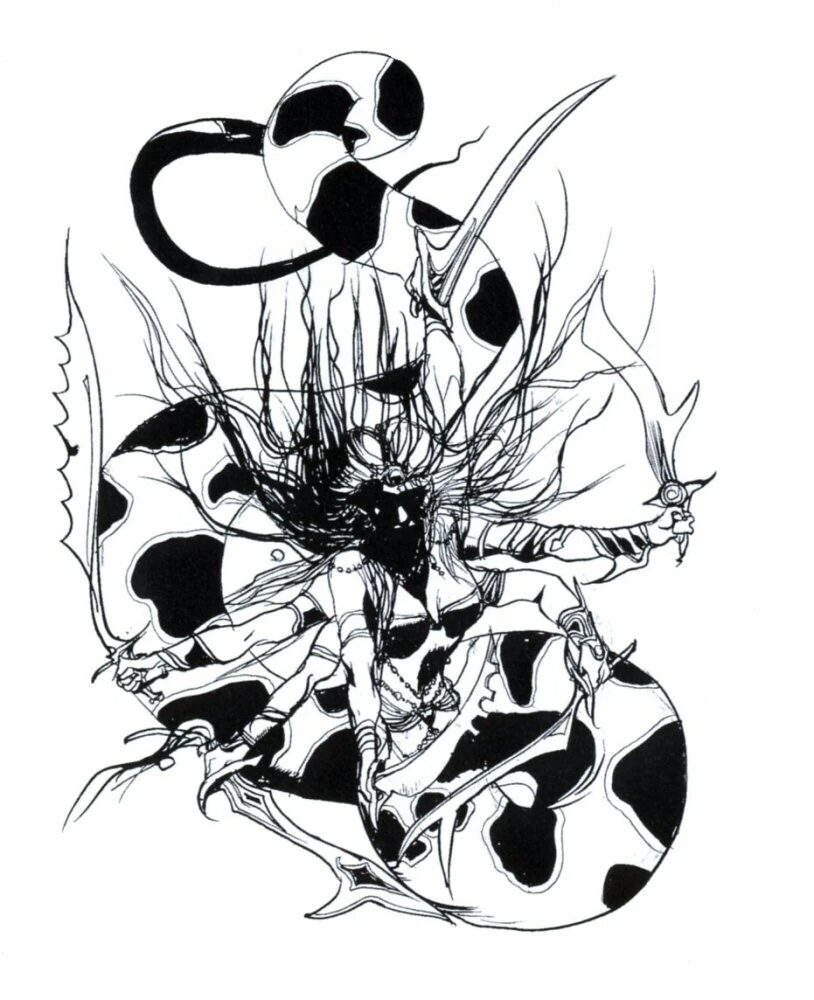
Just over a decade after their first appearance in Dungeons and Dragons, mariliths appear in the first Final Fantasy game as one of the elemental fiends, the four major bosses your party of heroes must defeat to restore the four crystals (or orbs, depending on the translation).
In the Final Fantasy series, Marilith almost always refers to a single unique entity, usually a boss, rather than a species of demons as they appear in Dungeons and Dragons.
Marilith is the Fiend of Fire, attacking with strong physical attacks and fire spells, perhaps inspired by the cause pyrotechnics ability of the D&D creature. You actually fight her twice in the game — in her second appearance, she uses more powerful fire spells (and uses her spells somewhat more often) and gains a Death spell.
In the Famicon version, her name appears as ‘マリリス‘ or Maririsu — in English, Marilith. For the NES version, however, the name was changed to ‘KARY’ — this is likely a mistranslation of Kali. Some fans speculate the name change was done to avoid copyright infringement issues with TSR, but it could also be due to character limitations on the NES — many creatures’ names were changed to shorten them.
Marilith’s battle sprite in various ports of the original Final Fantasy:
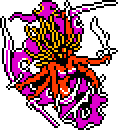
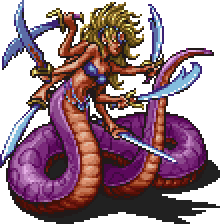
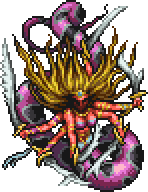
Did Squaresoft copy TSR?
I’m going to go out on a limb here and say yes, almost certainly.
This interview with Akitoshi Kawazu, who designed Final Fantasy’s battle system, cites D&D as a huge inspiration for the game.
Aside from Marilith, mind flayers, beholders, and sahaugin, other monsters from the first game were inspired by D&D monsters, even if their spritework varied more from D&D’s official artwork.
Centipedes, just called PEDE in the NES release, have the Japanese name “アンクヘッグ or Ankuheggu — the most recent translations of the game rename them to Ankheg.
Another monster, known to US gamers as the burrowing, heavily armored ANKLYO, has the Japanese name バレッテ or Barette. Due to the way Japanese tends to handle Rs and Ls, it’s most likely inspired by the Bulette. This seems to be confirmed: FFV has the same creature translated as Bulette in the most recent edition of the game.
So why didn’t TSR sue Squaresoft for copyright infringement?
I’m not really sure. Maybe they were flattered to see their creations in a Japanese videogame — it’s a testament to how far the game they created had grown if it was being played in Japan.
TSR was also trying to avoid legal issues from their own use of work from J.R.R. Tolkien’s Middle Earth universe, so they may have felt it wasn’t worth getting into more legal fights.
This article offers another perspective: maybe TSR wasn’t sure they could win against Squaresoft, which would open up even more of their creatures being used by other developers.
Either way, Marilith and other D&D-inspired monsters continue showing up in the Final Fantasy series, although later games would take steps to alter the names or appearances to at least add some plausible deniability if TSR/WotC ever took them to court.
Let’s look at the development of mariliths in D&D and Final Fantasy since 1987.
D&D mariliths finally make the jump to videogames (1991 & 1993)
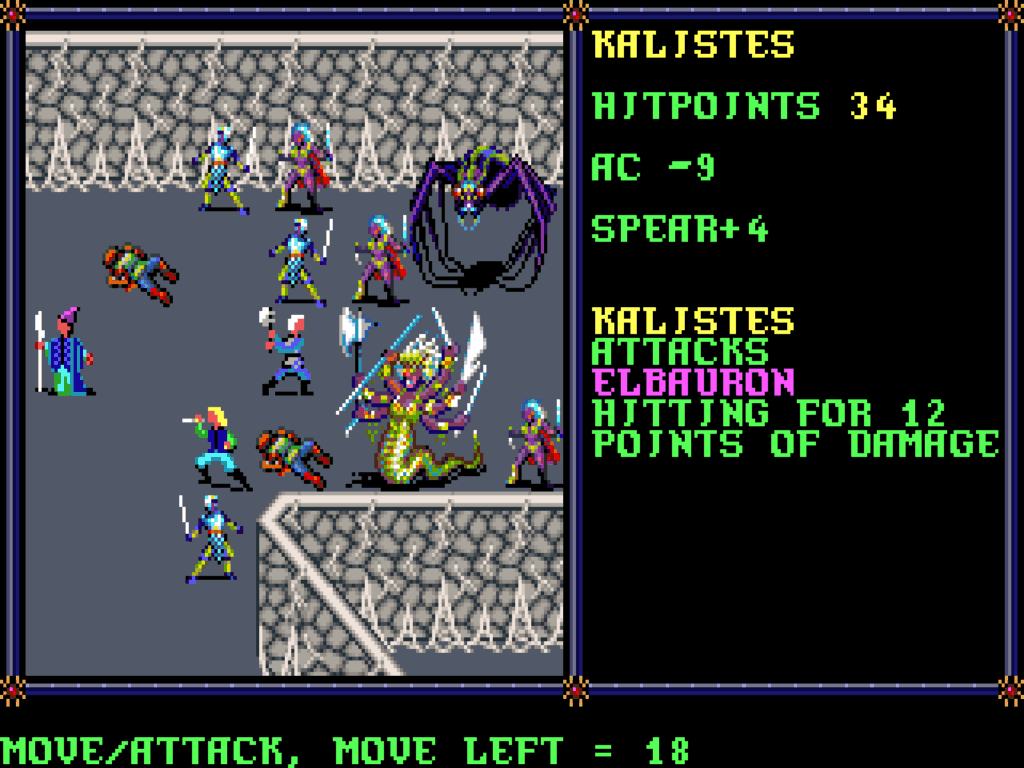
From what I can tell, the first videogame appearance of a D&D marilith is the 1991 Pools of Darkness, part of the Pool of Radiance series by Strategic Simulations Inc.
A sequence in the game takes your party of adventurers into the spider realm of the marilith Kalistes, reminiscent of the 1980 AD&D module, Queen of the Demonweb Pits.
A couple years later, mariliths reappear in 1993’s Forgotten Realms: Unlimited Adventures.
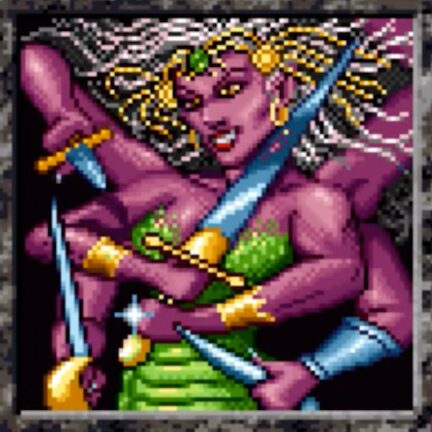
The 90s Final Fantasy Interlude
Mariliths don’t show up much in Final Fantasy during the 90s, aside from this odd specimen from Final Fantasy IV (1991):

The Final Fantasy Fandom wiki calls this creature a “Lesser Marilith,” but I’m not sure I agree. The Japanese name is マリード or Marīdo — in English, “Marid.”
Marid is an Arabic word applied to genies and jinn — and in fact Dungeons and Dragons uses the term to refer to water-elemental genies. I think the “tail” of the creature looks more like wisps of smoke akin to common depictions of a genie than a serpent’s tail, personally, although the hair is somewhat similar to what we see in other depictions of Marilith in Final Fantasy.
Most English translations of the creature refer to it as Screamer, with its palette swaps named Weeper and Grudger.
Only the translation for the PSP version of the game refers to the creature as a Lesser Marilith, most likely the result of a mistranslation of the original Japanese.
Marilith DOES appear in the Gameboy game Final Fantasy Adventure, also from 1991. Oddly enough, this version uses ice spells instead of fire.

FF Adventure, known as Seiken Densetsu, is the first game in the Mana series and is not considered a true Final Fantasy game, despite the name. Funnily enough, this spawns a whole separate branch of mariliths appearing in the Mana series of videogames, but that’s a topic for a future article.
Mariliths in AD&D 2nd Edition (1993)
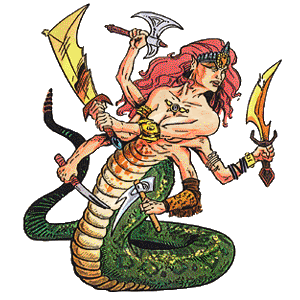
Mariliths return in 1993’s Monstrous Manual for the 2nd edition of Advanced Dungeons and Dragons. Their description is fleshed out quite a bit, likely because the Planescape campaign setting and all its juicy lore about devils and demons is just around the corner.
Curiously, this text refers to “marilith” as both a singular and plural word — other editions use “mariliths” as the plural form.
Bold and cunning, marilith are the generals and tacticians for the Blood War.
Where the balors are the influence and energy behind the war effort, the marilith are the brains and tactics.
[…]
Marilith always carry a different weapon in each hand, favoring exotic swords and axes. The DM should assign specific weapons; 90% of them should be enchanted versions of the common variety, and 15% of those should be a special weapon. Marilith favor their weapons highly. If one should ever be lost or stolen, marilith go to great lengths to see that the weapon is recovered.
[…]
As noted, marilith are the strategists of the Blood War. They are in charge of devising all tactics to be used during the battles and coordinate the activities of all true tanar’ri (save the mighty balors, of course). Due to the chaotic nature of the tanar’ri, it is not really possible to coordinate their activities, but the marilith are charged with it, nonetheless.
These stunningly powerful creatures have a hatred for the glabrezu. They feel that the subtle warfare of the glabrezu is a children’s game and inferior to proper warfare. A marilith will attempt to discredit the workings
of the glabrezu any chance it gets. They would completely destroy the subtle beasts, but the all powerful balors favor the glabrezus’ tactics and would have them continue their ways.Marilith are true tanar’ri, which makes them a part of the driving force behind the Blood War. Moreover, they are the coordinators and generals of the war effort. Marilith feel that they are the true force
behind the war. Secretly, they feel that the balors have their place only because of their great power, but are not absolutely necessary. They may be right in their belief, but the power of the balors remains unchallenged.
The extra details about the rivalries between mariliths and glabrezu/balors are great and really help flesh out the chaotic tanar’ri.
2nd edition mariliths get a few new tricks, able to animate dead, drop cloudkill spells, and curse their foes.
Due to the popularity of the Planescape setting, mariliths appear often in books and adventures of the era.
Marilith in Final Fantasy IX (2000)
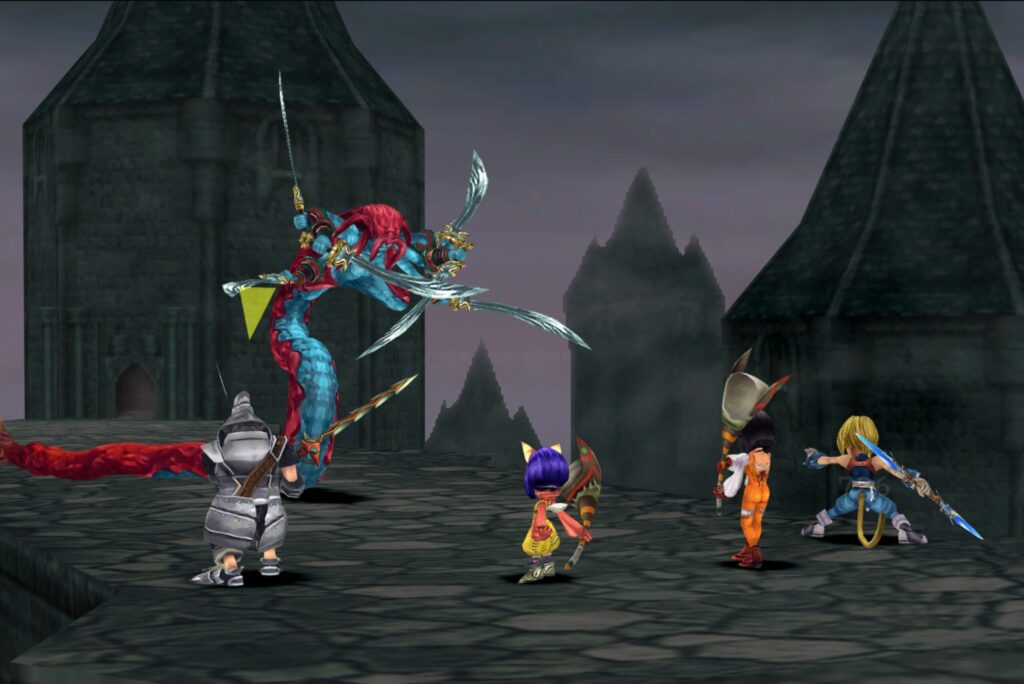
Marilith returns to the Final Fantasy series in Final Fantasy IX for the Playstation. Translated as “Maliris” for the English release, she is similar to her first incarnation as the fiend of fire, attacking with physical attacks and fire spells.
FF9’s Marilith is fought in Memoria, one of the final dungeons of the game.
She has a few new tricks in this game, casting Reflect on herself and finishing the fight with a powerful Raining Swords ability that deals thousands of damage to your entire party.
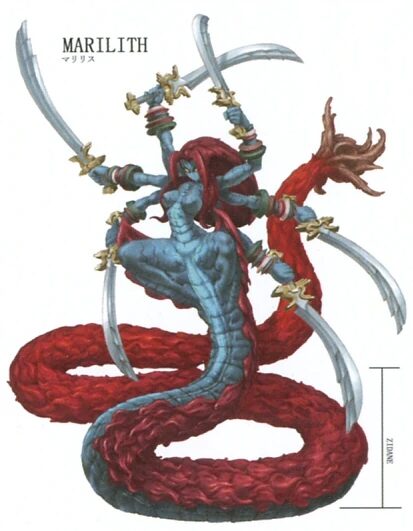
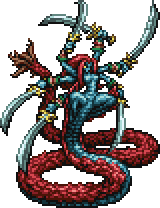
Mariliths in D&D 3.0 / D&D 3.5 Edition (2000)
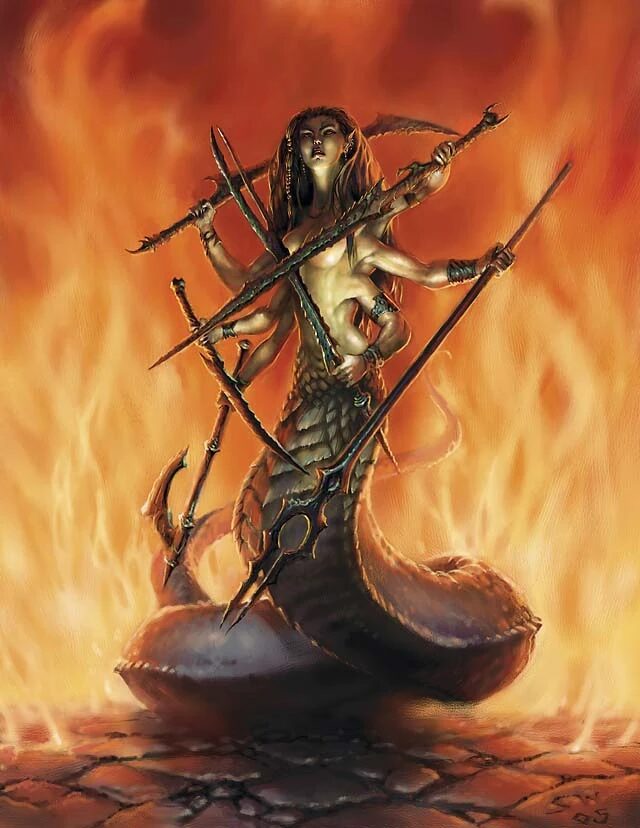
Also in 2000, the release of D&D 3rd edition sees the mariliths return in the Monster Manual. Their lore is largely the same as their 2nd edition counterparts, but they lose their pyrotechnics ability, their ability to animate dead, and their cloudkill spells, but gain blade barrier and a few weapon-related spells.
The marilith Yxunomei appears in the Icewind Dale videogame this year too:
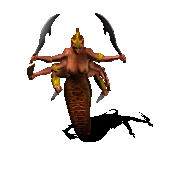
Marilith in Final Fantasy XII (2006)
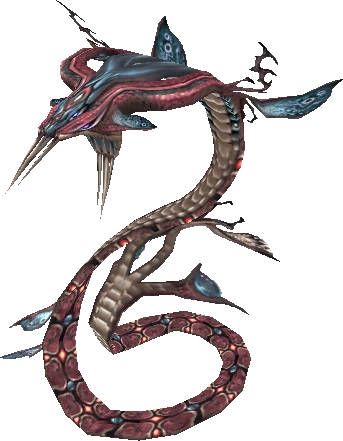
A creature called Marilith appears as a Rank V Mark in Final Fantasy XII.
For the most part, this version of Marilith deviates from the patterns we’ve seen before in the Final Fantasy series — it only attacks with physical attacks and its Tail Spear special attack, which can inflict the Slow and Sap status effects. It starts with the Protect, Shell, and Haste buffs.
It does absorb fire damage, but for the most part the creature feels like an allusion to earlier incarnations of Marilith than a new appearance of the Fiend of Fire.
The Serpent’s Eye it drops is an ingredient in the crafting chain to make the Tournesol, the strongest greatsword in the game.
DDO and Neverwinter Nights 2 (2006)
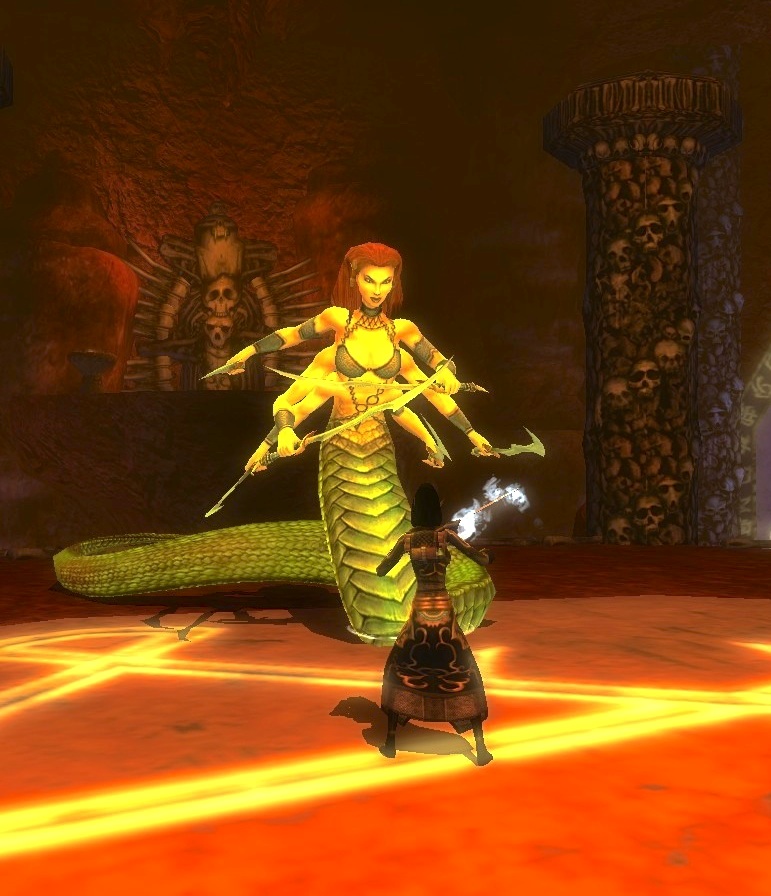
2006 was a good year for Dungeons and Dragons MMOs. Dungeons and Dragons Online was released. A number of mariliths appear in the game, including the raid boss Queen Lailat.
Neverwinter Nights 2 also came out, which gave us this killer piece of concept art. I love the shift to a more demonic appearance of the face:
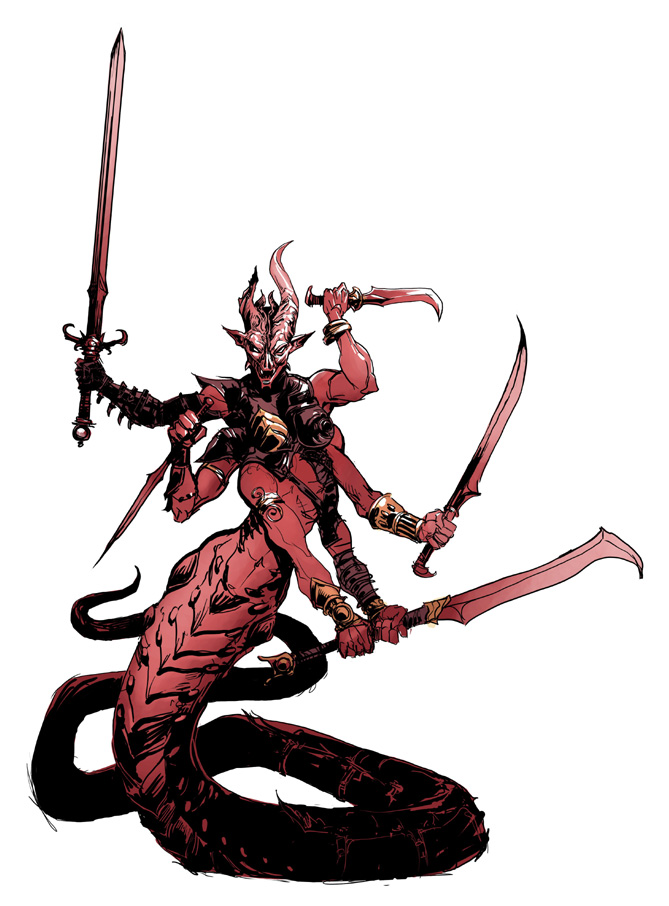
Marilith in Final Fantasy IV: The After Years (2008)
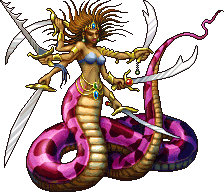
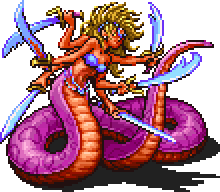
Although one of the lesser known Final Fantasy titles, the sequel to Final Fantasy IV, titled Final Fantasy IV: The After Years has received a number of ports over the years.
Originally a mobile game, The After Years was released on the Nintendo Wii as a downloadable game on WiiWare and later ported to the Playstation Portable.
Marilith appears in both versions as a boss in the endgame, alongside the rest of the fiends from FF1. Interestingly, the Wii version uses the Marilith sprite from the Final Fantasy: Dawn of Souls game for the Gameboy Advance, while the PSP version uses the sprite from the Playstation Portable port.
In this incarnation, she uses Entice to confuse party members, counters magic with Silence, and uses heavy fire attacks like Firaga and Blaze.
From what I can tell (I haven’t play it yet), Marilith and the other fiends from FF1 were removed from the 3D remake of The After Years. Since WiiWare games are no longer obtainable, the PSP release is your best bet if you want to fight this version of Marilith.
Mariliths in 4th Edition D&D (2008)
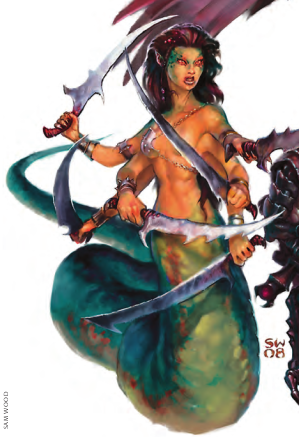
I gotta be honest. I usually like 4e monster design, but 4th edition Dungeons and Dragons does the marilith dirty.
All of their magical abilities are gone. No pyrotechnics, no teleport, no darkness. They don’t even get the ability to summon other demons, something that has been part of their kit from the beginning.
Instead, 4e mariliths get a reaction ability that lets them make an attack when a creature misses them, a parry ability that increases their AC by 4, and a special ability that lets them make six attacks in a round, which they can use once and then a second time when they become bloodied.
That’s a big downgrade from the powerhouse they were in 3.5.
Other Marilith appearances in Final Fantasy
Marilith has appeared in a handful of other Final Fantasy games and content, mostly spin-offs and mobile games.
- A bald, two-armed version appears in Final Fantasy Legend (which is actually a game in the SaGa series) for the Gameboy.
- She shows up in the Dissidia Final Fantasy games as a summon, using a colorized version of the original Yoshitaka Amano concept art.
- She appears in several of the mobile games as a digital collectible card or boss fight, usually reusing spritework from ports of the original Final Fantasy.
- Several versions appear in the Final Fantasy Trading Card Game.
- BONUS: Marilith appears as a boss in the fan-made Final Fantasy IV Ultima romhack!
Here are a few more notable appearances:
Brotherhood Final Fantasy XV
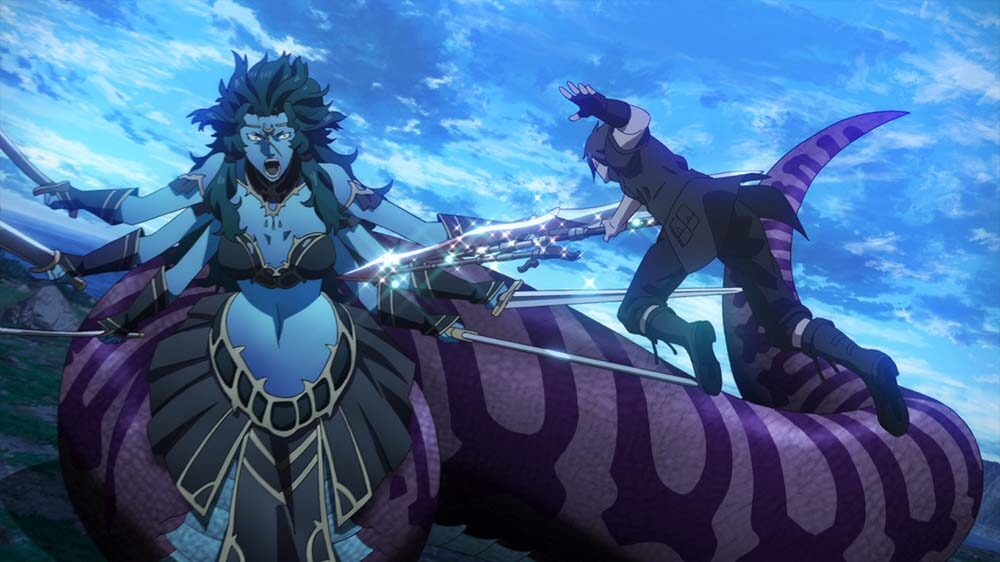
Marilith appears in the prequel anime to Final Fantasy XV. Oddly enough, she doesn’t appear in the game itself.
World of Final Fantasy: Maxima
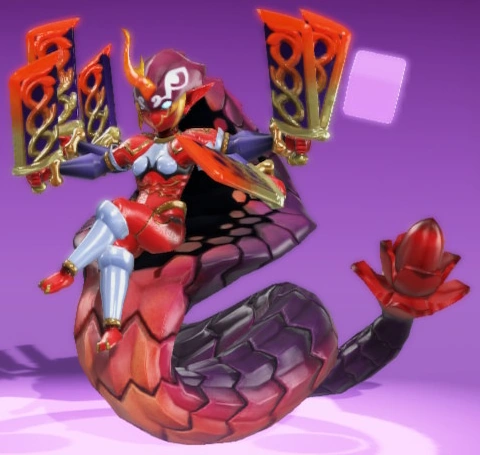
Marilith appears as a superboss in this expansion to World of Final Fantasy for the PS4, Xbox One, Nintendo Switch, and PC. It’s an interesting take on the character, and one of the few times we see her with legs.
Mobius Final Fantasy
Terrible voice acting aside, this mobile game had a pretty cool rendition of Marilith.
Final Fantasy Dimension II
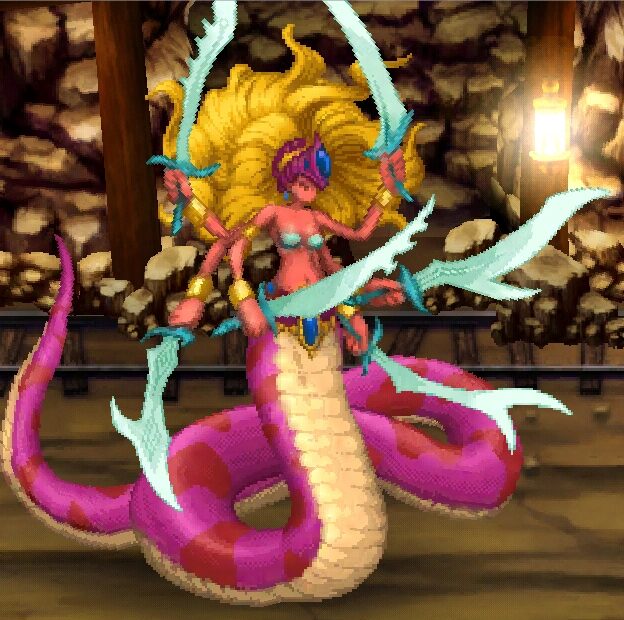
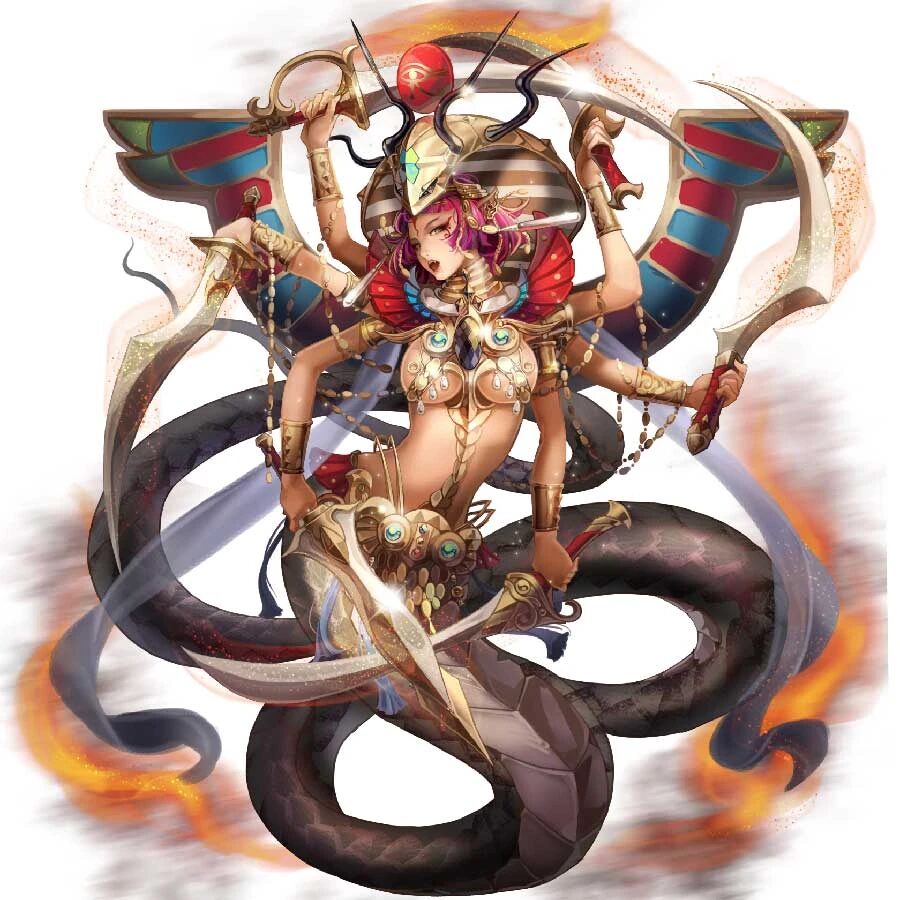
Marilith appears in this mobile game both as a boss fight and as a summon.
Mariliths make a comeback in D&D 5th Edition (2014)
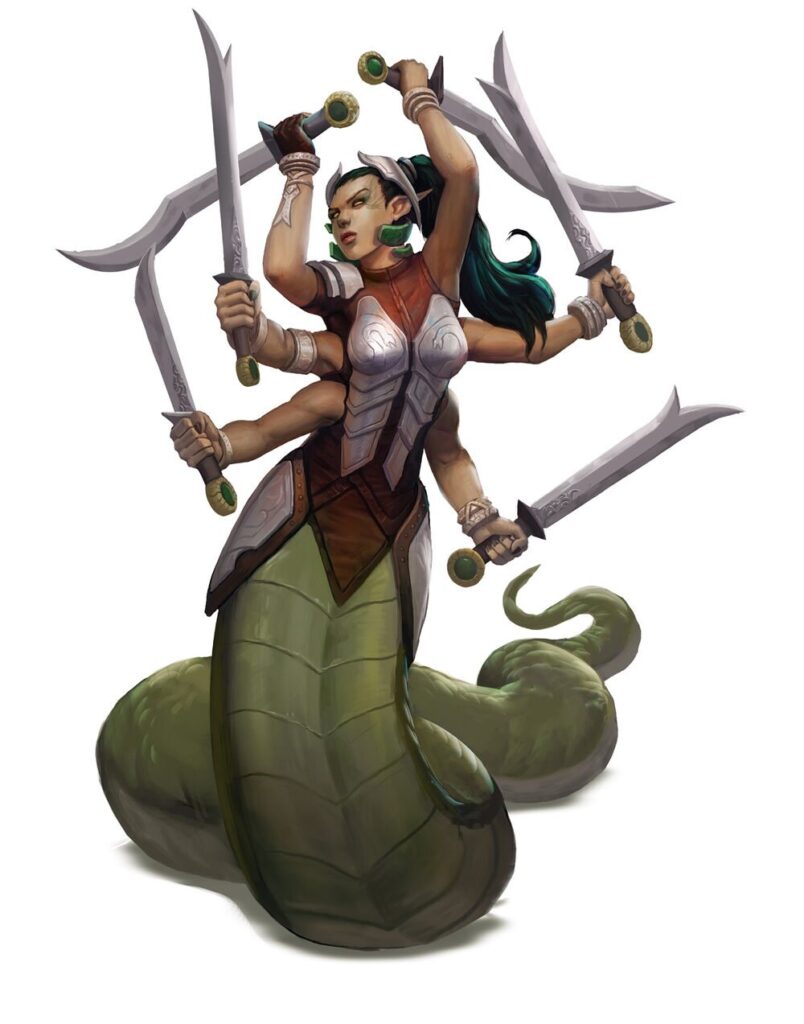
After their lackluster showing in 4th edition, mariliths are back in business in Dungeons and Dragons 5th edition. Although they still don’t have quite as many magical abilities as they used to, they get their teleport back and have regained full use of their arms, allowing them to make six sword attacks per round (plus a tail slap).
They even have a parry ability similar to their 4e version, now usable as a reaction.
Stranger of Paradise: Final Fantasy Origins (2022)
Finally, one of my favorite Final Fantasy depictions of Marilith comes from Stranger of Paradise, a spin-off action RPG retelling of the first Final Fantasy game.
Her design here is top tier, with flaming eyes, a wicked array of attacks, and a killer music track.
I mean, just watch:
If you want some inspiration for a terrifying marilith enemy for your Dungeons and Dragons game, you can’t go wrong by studying this incarnation of our favorite stabby burny six-armed snake lady.

